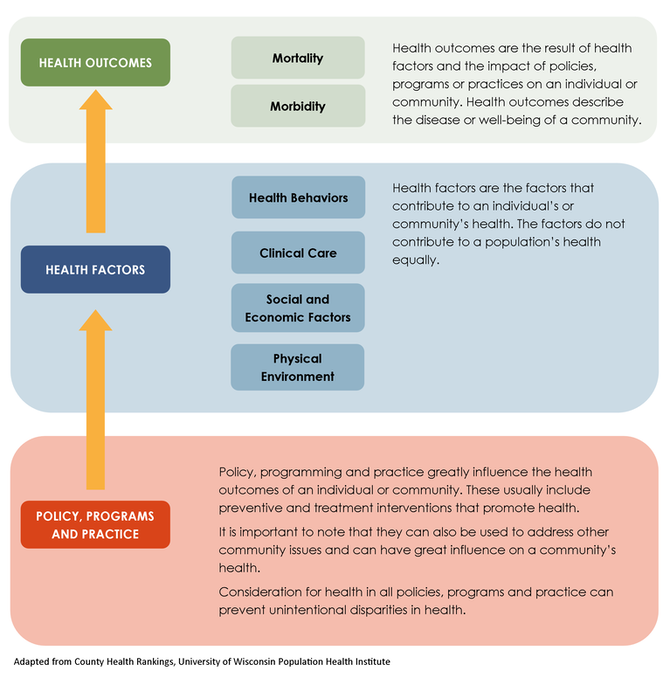
What is Population Health?
Population health has been described variously as: (1) A conceptual framework for thinking about why some populations are healthier than others, as well as the policy development, research agenda, and resource allocation that flow from it (Young 1998); (2) The health outcomes of a group of individuals, including the distribution of such outcomes within the group (Kindig and Stoddart 2003; Kindig, 2007; Kindig, Asada, & Booske, 2008); and (3) The health of a population as measured by health status indicators and as influenced by social, economic, and physical environments; personal health practices; individual capacity and coping skills; human biology; early childhood development; and health services (Dunn and Hayes 1999).
Taken together, the population health perspective provides a research framework to better understand and address the health and well-being of communities. The framework then is a conduit for identifying determinants of health, disease, and well-being in populations; designing and implementing preventive and treatment interventions that promote health; and measuring effectiveness.
Why Use this Framework?
The population health framework recognizes the complexity of issues facing the health of our communities and provides an approach that can assess, address and evaluate. The premise here is that change must not be focused only on individuals, or families, or communities, but must authentically involve said groups and other systems such as the health, social service, educational or justice systems and sectors such as government and voluntary sectors to affect change.
This framework, in its grouping of health determinants recognizes the importance of both internal and external risk factors. This is important to both identifying opportunities for intervention and stimulating cross-sector partnerships to address community level issues affecting the health of our community.
How Do We Use the Framework?
The Center for Urban Population Health realizes this framework through multidisciplinary, multi-institutional, multi-stakeholder partnerships which use a systematic approach to learn and address population health disparities that fall along the translational continuum from health sciences to community. This includes engaging in the community and including stakeholders at every level of the process.
Guided by current evidence, this approach has the promise of innovation and community impact. Equally important to this approach is the knowledge transfer that takes place among partners and between stakeholders through our work.
Population health has been described variously as: (1) A conceptual framework for thinking about why some populations are healthier than others, as well as the policy development, research agenda, and resource allocation that flow from it (Young 1998); (2) The health outcomes of a group of individuals, including the distribution of such outcomes within the group (Kindig and Stoddart 2003; Kindig, 2007; Kindig, Asada, & Booske, 2008); and (3) The health of a population as measured by health status indicators and as influenced by social, economic, and physical environments; personal health practices; individual capacity and coping skills; human biology; early childhood development; and health services (Dunn and Hayes 1999).
Taken together, the population health perspective provides a research framework to better understand and address the health and well-being of communities. The framework then is a conduit for identifying determinants of health, disease, and well-being in populations; designing and implementing preventive and treatment interventions that promote health; and measuring effectiveness.
Why Use this Framework?
The population health framework recognizes the complexity of issues facing the health of our communities and provides an approach that can assess, address and evaluate. The premise here is that change must not be focused only on individuals, or families, or communities, but must authentically involve said groups and other systems such as the health, social service, educational or justice systems and sectors such as government and voluntary sectors to affect change.
This framework, in its grouping of health determinants recognizes the importance of both internal and external risk factors. This is important to both identifying opportunities for intervention and stimulating cross-sector partnerships to address community level issues affecting the health of our community.
How Do We Use the Framework?
The Center for Urban Population Health realizes this framework through multidisciplinary, multi-institutional, multi-stakeholder partnerships which use a systematic approach to learn and address population health disparities that fall along the translational continuum from health sciences to community. This includes engaging in the community and including stakeholders at every level of the process.
Guided by current evidence, this approach has the promise of innovation and community impact. Equally important to this approach is the knowledge transfer that takes place among partners and between stakeholders through our work.
|
Want to learn more?
Watch this brief video. |
|
